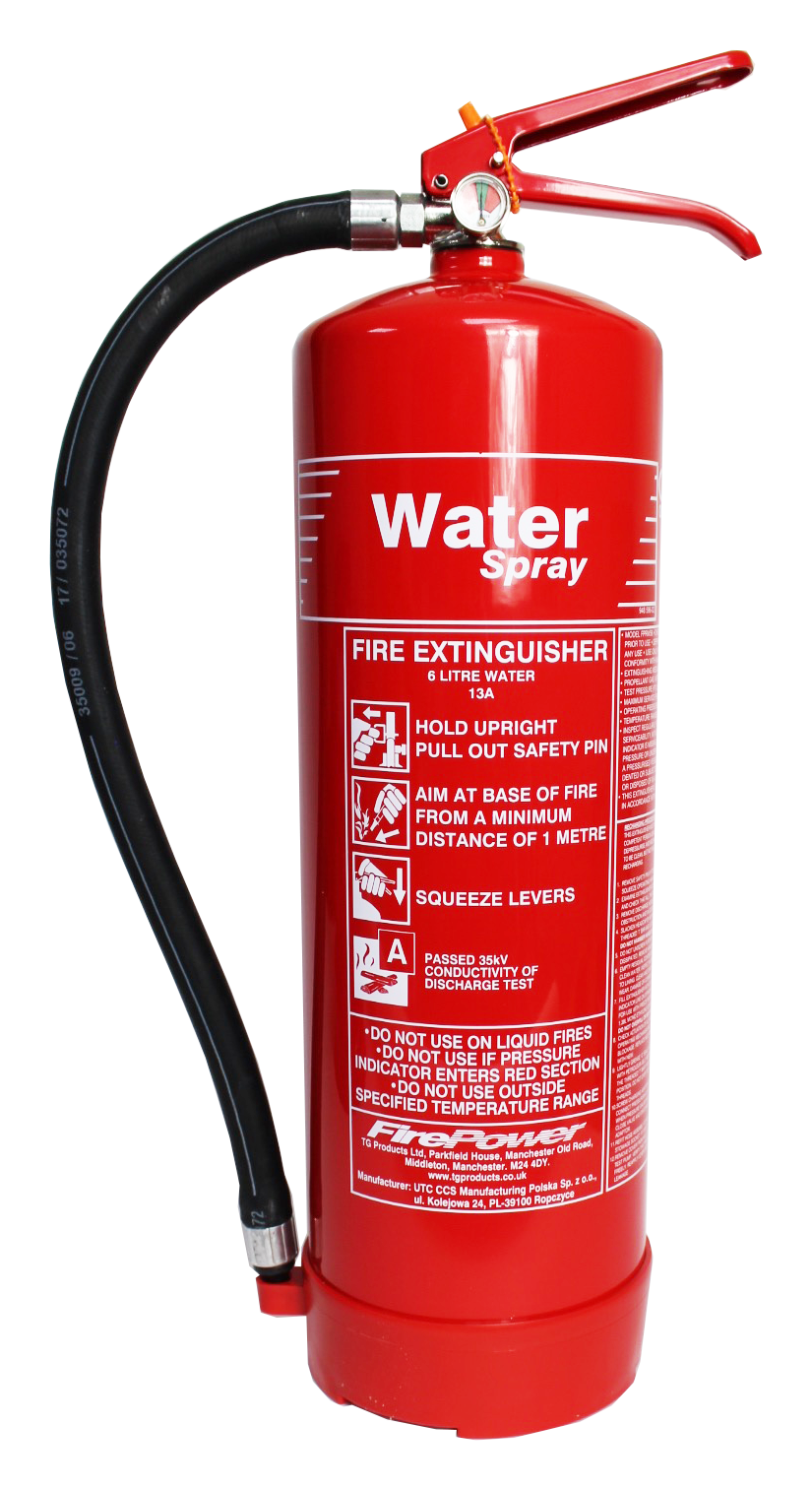
Water Fire Extinguishers
H20 - Charged with Nitrogen or Air
Water fire extinguishers are the most common extinguishers in the market. As the name suggests they contain H20 or water which is pressurised with nitrogen or compressed air.
Water is a Class A fire extinguisher. This means that it can (only) be used on the following sources of fire: Wood, Paper, Textiles, Plastics, Hay, and Straw it works by dousing the flames, which as we know will efficiently extinguish fire, providing it is only used on the above sources.
Therefore, it should NEVER be used on live electrical items, flammable liquids, gaseous fires, or metal fires this could cause severe damage to the user in the case of live electrics and would exacerbate the fire in the case of all other sources therefore another extinguisher MUST be used for anything else.
Water based fire extinguishers are designed to fight 'Class A' fires
They come in three different sizes, 3, 6 and 9 Litre.
Kite-marked to British and European Standards.
Corrosion Resistant Paint and Polythene Lining to protect from Internal Corrosion.
Protective Plastic Base.
Comes with a wall hanging bracket for easy mounting.
Suitable for Offices, Shops, Restaurants, Hotels, Schools, Places of Worship and Residential properties.
Often Coupled with a Carbon Dioxide for better Fire Protection.
Includes a full 5 year warranty.
6 Litre Water Fire Extinguisher
6-Litre water fire extinguishers carry an '8 A' Fire Rating and it is safe for use on wood, paper, plastic, straw, textile and similar man-made fibres. Never use water on live electrics.
For best results, place the extinguisher on the floor and spray the jet of water at the base of the flames in a sweeping motion once the fire has been drenched pick up the extinguisher and encircle the fire if possible.
9 Litre Water Fire Extinguisher
9-Litre water fire extinguishers carry an '13 A' Fire Rating and it is safe for use on wood, paper, plastic, straw, textile and similar man-made fibres. Never use water on live electrics.
For best results, place the extinguisher on the floor and spray the jet of water at the base of the flames in a sweeping motion once the fire has been drenched pick up the extinguisher and encircle the fire if possible.
Water extinguishers can be identified as having a R E D L A B E L with the word "WATER" clearly written in capital letters on the front of the extinguisher at the top, near the carrying handle.
As the sources of fire that water can tackle are so abundant in all types of environments, water fire extinguishers are located everywhere, in cinemas, offices, hospitals, workshops, storerooms, churches, shops, warehouses, schools, residential homes such as care homes.
(Due to the fact that it can only be used on certain fires they are often coupled with carbon dioxide fire extinguishers, which are better adept at tackling fires including live electrical fires, and flammable liquids. Carbon Dioxide is easily identified as having a black label with the words “CARBON DIOXIDE” written in capital letters on the front of the extinguisher at the top, near the carrying handle).
The purpose of any fire extinguisher is to facilitate an efficient escape from a building which is on fire, therefore you are most likely to find a fire extinguisher located near to exits and stairways.
If you discover a small fire which could spread, or a building is on fire and the exit out of a building is blocked by fire you should quickly locate the nearest fire extinguisher, place the extinguisher on the floor. All fire extinguishers have a flat base to prevent them falling over.
First, remove the tamper seal by pulling sharply on the plastic tag, then without pressing on the handle, remove the safety pin (the safety pin is designed to prevent accidental activation). Remove the hose from its holster and hold the hose near the nozzle, whilst aiming the hose at the base of the fire, with your other hand, gently squeeze the two handles together. This will activate the extinguisher and the pressurised water will flow and you can now begin to extinguish the flames in order to make your escape.
The most efficient way of tackling any fire is to begin by spraying the base of a fire in a gentle sweeping motion laying layers of water down. Once you have knocked the flames down somewhat it may be possible to begin to encircle the fire to try and tackle it from all sides, if you can get on three sides of a fire there is far greater chance that the fire be extinguished.
Once you are sure the flames have been doused sufficiently enough to get everybody out to safety, you should put the fire extinguisher down and guide everyone out of the exit and get as far away from the building as possible. You should head to a fire assembly point where the responsible person should do a roll-call. Immediately call the emergency services if you haven't already done so - DO NOT GO BACK IN TO A BURNING BUILDING UNDER ANY CIRCUMSTANCES!
For more information, or to book a fire safety training session, please click below, or feel free to give us a call on the telephone number listed.




